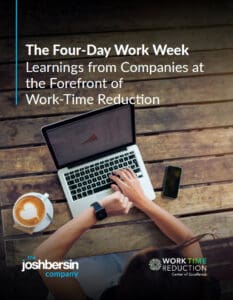The Four-Day Work Week: An Idea Whose Time Has Come
We just completed a large study of the 4-day work week and the results are clear. Under the right conditions it really works. And the results are very positive: improvements in employee health and wellbeing, increases in productivity, and overall improvement in revenue, profit, and customer service.
Wait a minute. Are you actually saying that real “work-time reduction” (WTR), without reducing pay, actually helps companies make more money?
And the answer is yes. When implemented well, work-time reduction (many versions: 6-hour workdays, half-day Fridays, 9-day fortnights) encourages companies to be more efficient, it gives people a more flexible and fulfilling life, and it forces the company to focus.
 In June 2022, 61 UK-based companies participated in a pilot program to study a four-day work week. As of February 2023, when the first results were published, 92% said they were continuing to test the concept with 29% saying the policy is a permanent change. Average organizational revenue rose by 1.4%; pilot companies also reported a 57% decline in the likelihood that an employee would quit, plus a 65% reduction in the number of days taken off as paid sick time.
In June 2022, 61 UK-based companies participated in a pilot program to study a four-day work week. As of February 2023, when the first results were published, 92% said they were continuing to test the concept with 29% saying the policy is a permanent change. Average organizational revenue rose by 1.4%; pilot companies also reported a 57% decline in the likelihood that an employee would quit, plus a 65% reduction in the number of days taken off as paid sick time.
Since then, as our research points out, the impact is growing much wider.
History Points To This Trend
How did we get to the 5-day week in the first place? If you look at the history of work, we had seven-day workweeks in the 1800s, followed by the five day week (pioneered by Henry Ford) in the 1920s, the Fair Labor Standards Act which established a maximum of 44-hour weeks in 1938, and lots of experiments since.
Hybrid work, which we all know well from the pandemic, has accelerated this trend.
In the last few years, Nasa, Microsoft Japan, Unilever, Shake Shack, Panasonic, and many others are experimenting. And based on what our research found, when these organizations focus on reducing wasted time in meetings, improving work productivity, and clarifying accountability and schedules, the results can be very positive. Employee engagement goes up and both revenue and profitability increased.
What could explain this effect? As our research points out, the “five-day week” is an artificial construct we’ve been living with for 100 years. Now that remote work, flexible work, and AI-powered scheduling systems are available, we don’t have to operate in this traditional “work week” fashion anymore.
Younger Workers Demand The Flexibility
And younger workers, many of whom had difficult work experiences during the pandemic, are voting with their preferences. Just look at major memes like “act your wage” or “lazy girl jobs” or “quiet quitting” or “work boreout.” These are not just social media memes: they are the voices of millions of workers telling employers that they simply do not and will not abide by traditional work norms.
Let’s face it. Even baby-boomers like me remember days in the office when I was bored, tired, or just wasting time. Meetings would drag on to fill empty space, then followed by long coffee breaks and times to go out for lunch. Yes of course these were always valuable ways to meet people and collaborate, but ultimately I always felt I was wasting a lot of valuable time. And there were days I was so tired I actually took a nap on the floor.
(Note that the following videos have been watched more than 20 million times, equivalent to one out of eight workers in the US.)
Rather than “fill the work to fit the time” we seem to “fill the time to fit the work.” In other words, the “five-day week” simply guarantees that we’ll be in the office or at our desks until Friday at 5. It says nothing about what we’ll do, how we’ll spend our time, or how efficient our time will be.
And of course there’s the issue of schedules, customer service, patient care, and various schedules. Once we know the scheduled hours for customers, passengers, or other needs, we can simply change our schedules to accommodate business needs.
Let me read you a great quote from this important research:
If squeezing 5 days of work into 4 is a concern for leadership, one consideration is Parkinson’s Law, which states, “Work expands to fill the time allotted for its completion.” In other words, employees will fill the time they have to complete tasks. If we reduce the time available, we surprise ourselves with how much we’re able to complete. And removing excess time spent on administrative or “unproductive” tasks frees up tangible hours to put back into quality, productive work.
Work Redesign Is The Next Big Thing
One more point. While I know most of you are wincing at this topic, I want to remind you that AI and automation will to force us to redesign almost every job in business. And as our Dynamic Organization research points out, work redesign is all about helping people work at the “top of their license,” clearly assigning accountability, and relentlessly focusing on the outcome or responsibility at hand. Nowhere in the principles of Organization Design do we mandate that people show up Monday at 8 and leave work Friday at 5.
We will be doing a series of webinars on this topic, and our research members can dive into the study and learn more. To really understand this topic, join our Organization Design SuperClass in The Josh Bersin Academy or join our corporate membership and we’ll show you what this is all about. Click here to download the study and learn more. A special Action Guide is included.
Additional Information
The Organization Design SuperClass
Hybrid Working (Certificate Program In The Josh Bersin Academy)
The Joys Of Hybrid Work: Ten Things We’ve Learned
How Do You Design Your Organization For The Future?



